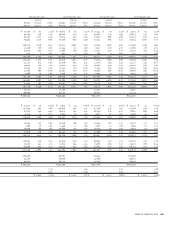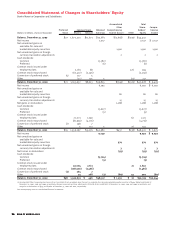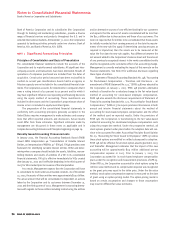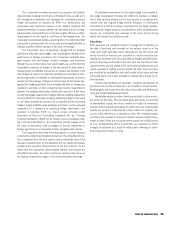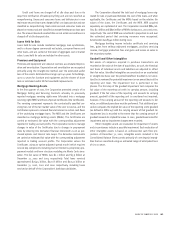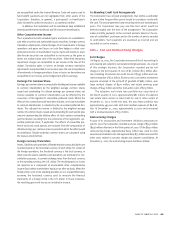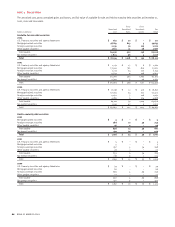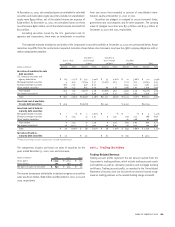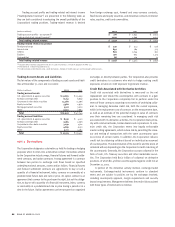Bank of America 2002 Annual Report Download - page 79
Download and view the complete annual report
Please find page 79 of the 2002 Bank of America annual report below. You can navigate through the pages in the report by either clicking on the pages listed below, or by using the keyword search tool below to find specific information within the annual report.
BANK OF AMERICA 2002 77BANK OF AMERICA 2002 77BANK OF AMERICA 2002 77
In determining the pro forma disclosures above, the fair value of
options granted was estimated on the date of grant using the Black-
Scholes option-pricing model and assumptions appropriate to each
plan. The Black-Scholes model was developed to estimate the fair value
of traded options, which have different characteristics than employee
stock options, and changes to the subjective assumptions used in the
model can result in materially different fair value estimates. The
weighted average grant date fair values of the options granted during
2002, 2001 and 2000 were based on the following assumptions:
As Reported Pro Forma
(Dollars in millions, except per share data)
2002 2001 2000 2002 2001 2000
Net income $ 9,249 $ 6,792 $ 7,517 $ 8,836 $ 6,441 $ 7,215
Net income available to common shareholders 9,244 6,787 7,511 8,831 6,436 7,209
Earnings per common share 6.08 4.26 4.56 5.81 4.04 4.38
Diluted earnings per common share 5.91 4.18 4.52 5.64 3.96 4.34
Risk-Free Interest Rates Dividend Yield
2002 2001 2000 2002 2001 2000
Key Employee Stock Plan 5.00% 5.05% 6.74% 4.76% 4.50% 4.62%
Broad-based plans 4.14 4.89 6.57 4.37 5.13 4.62
Expected Lives (Years) Volatility
2002 2001 2000 2002 2001 2000
Key Employee Stock Plan 77726.86% 26.68% 25.59%
Broad-based plans 44431.02 31.62 30.27
Compensation expense under the fair-value based method is
recognized over the vesting period of the related stock options.
Accordingly, the pro forma results of applying SFAS 123 in 2002,
2001 and 2000 may not be indicative of future amounts.
In November 2002, the Emerging Issues Task Force (EITF) finalized
the minutes to its discussion of EITF Issue 02-3, “Accounting for
Contracts Involved in Energy Trading and Risk Management Activities”
(EITF 02-3), which included clarification of the FASB staff’s view that an
entity should not recognize an unrealized gain or loss at inception of a
derivative instrument unless the fair value of that instrument is
obtained from a quoted market price in an active market or is other-
wise evidenced by comparison to other observable current market
transactions or based on a valuation technique incorporating observ-
able market data. This view is applicable to all derivative instruments
held for trading purposes entered into on or after November 21, 2002.
EITF 02-3 did not have a material impact on the Corporation’s results of
operations or financial condition.
FASB Interpretation No. 45, “Guarantor’s Accounting and
Disclosure Requirements for Guarantees,” (FIN 45) was issued in
November 2002. FIN 45 requires that a liability be recognized at the
inception of certain guarantees for the fair value of the obligation,
including the ongoing obligation to stand ready to perform over the
term of the guarantee. Guarantees, as defined in FIN 45, include
contracts that contingently require the Corporation to make payments
to a guaranteed party based on changes in an underlying that is
related to an asset, liability or equity security of the guaranteed party,
performance guarantees, indemnification agreements or indirect guar-
antees of indebtedness of others. This new accounting is effective for
certain guarantees issued or modified after December 31, 2002. In
addition, FIN 45 requires certain additional disclosures that are
located in Notes 8 and 13. Management does not expect that the adop-
tion of FIN 45 will have a material impact on the Corporation’s results
of operations or financial condition.
In June 2001, the FASB issued Statement of Financial Accounting
Standards No. 142, “Goodwill and Other Intangible Assets,” (SFAS 142).
SFAS 142 became effective for the Corporation on January 1, 2002 and
primarily addresses the accounting for goodwill and intangible assets
subsequent to their acquisition. SFAS 142 requires that goodwill be
recorded at the reporting unit level. The Corporation defines reporting
units as an operating segment or one level below. The Corporation has
evaluated the lives of intangible assets as required by SFAS 142 and no
change was made regarding lives upon adoption. SFAS 142 prohibits
the amortization of goodwill but requires that it be tested for impair-
ment at least annually at the reporting unit level. Goodwill was tested
for impairment and no impairment charges were recorded.
In accordance with SFAS 123, the Corporation provides dis-
closures as if the Corporation had adopted the fair value-based
method of measuring all outstanding employee stock options in
2002,
2001 and 2000 as indicated in the following table. The
disclosure
requirement of SFAS 123 recognizes the impact of all outstanding
employee stock options while the prospective method that the
Corporation intends to follow under SFAS 148 recognizes the impact of
only newly issued employee stock options.




